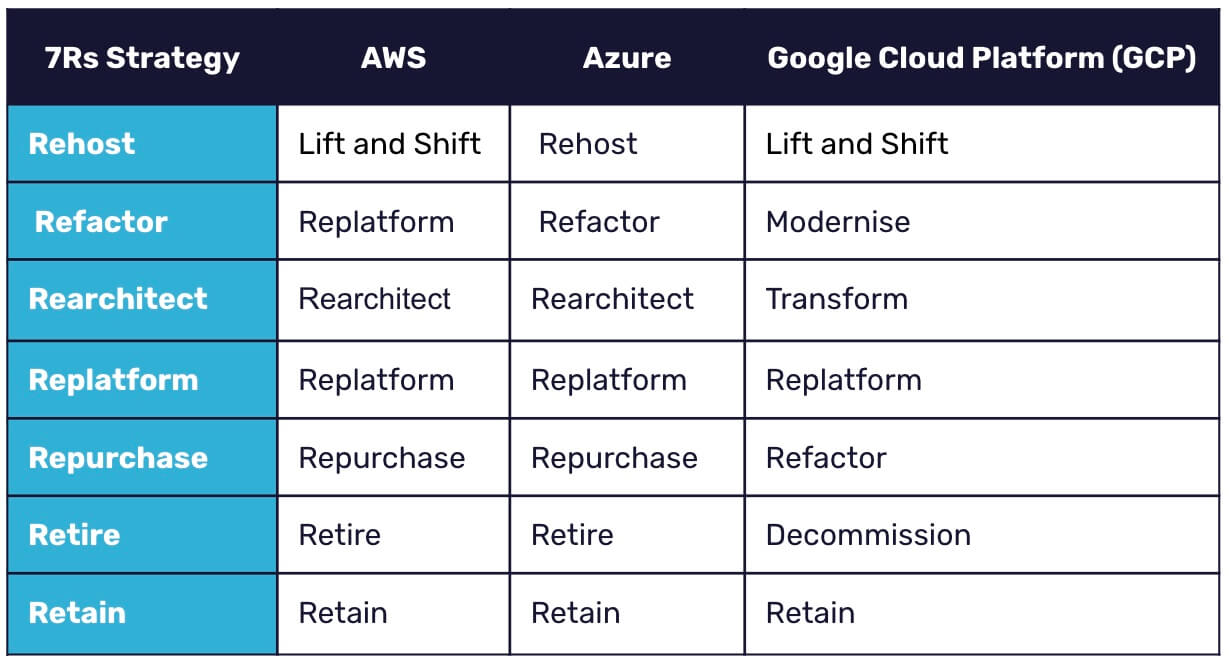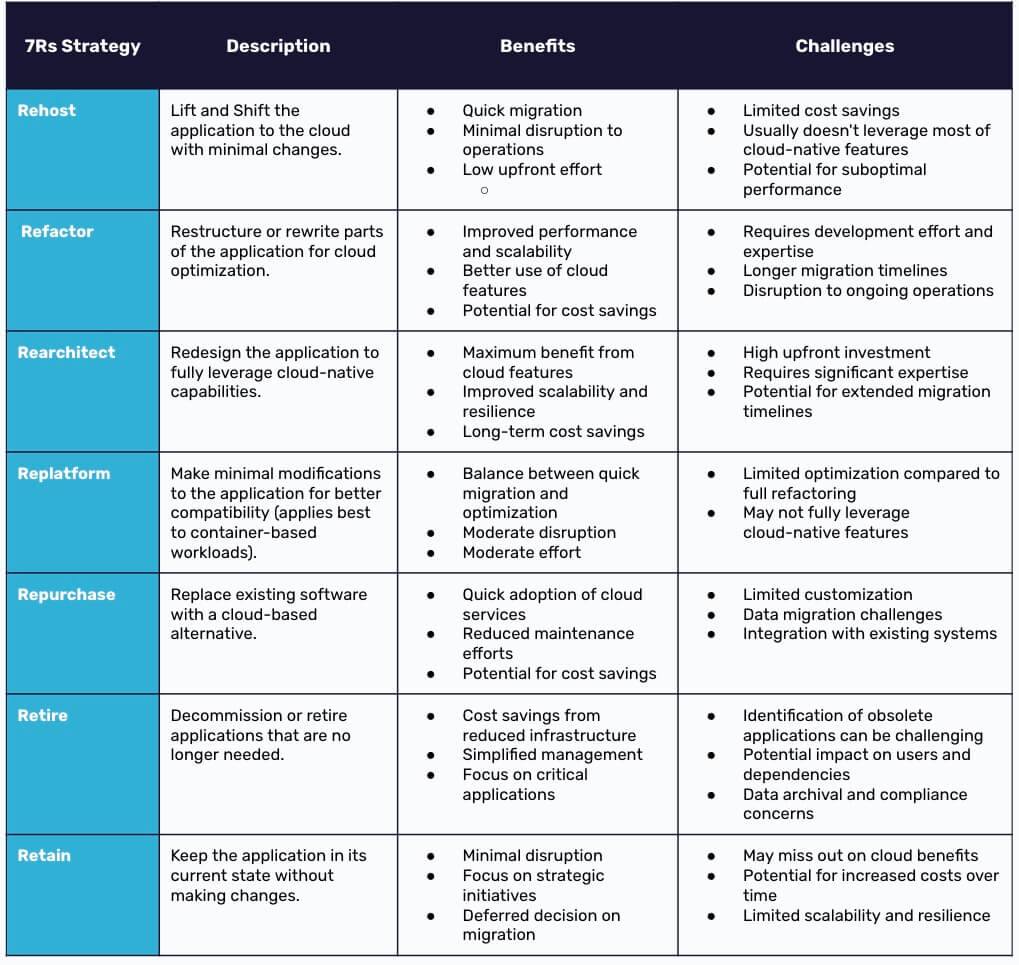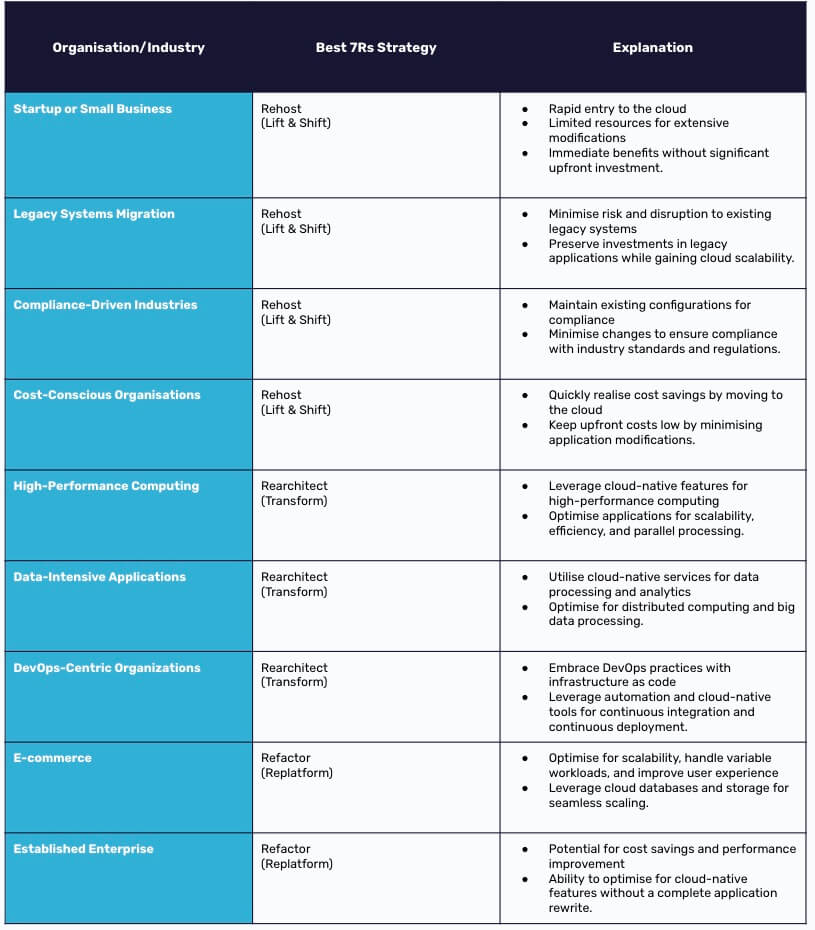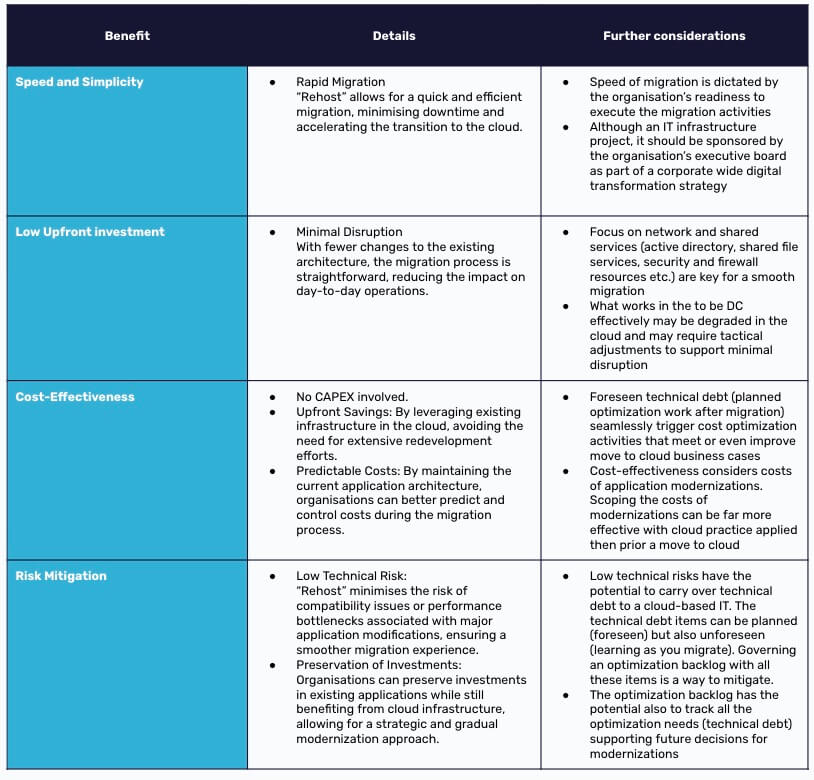
7Rs explained & why ‘Rehost’ can be the best choice for a DC exit
- Rehost - It’s a bit like moving house.
- Why would you consider rehost?
- The problem statement
- Why organisations face a “journey to cloud” challenge
- What do the hyperscalers call the 7Rs?
- How do the 7Rs compare?
- Do certain industries align with particular 7R strategies?
- Benefits of “Rehost” strategy and the potential of cloud-based IT
- The optimisation backlog
- How do you choose the right approach?
- Conclusion
Embarking on the journey to transition from a data center (DC) to the cloud inevitably brings the focus to the 7Rs strategies. Each ‘R’ in their own way promises to guide an optimal path to cloud adoption, depending on the needs of the application.
Among these, the ‘rehost’ approach offers some tangible advantages, showcasing speed and simplicity, especially when the focus is on the bulk transition of DC infrastructure to the cloud.
Despite inherent challenges, it uniquely opens a gateway to methodically address technical debt post-migration. It also offers an accurate IT asset inventory, rendering it a strategic choice.
Rehost - It’s a bit like moving house.
For ‘Rehost’ (or lift & shift) as a migration strategy, a good comparison is moving house.
The moving date serves as a time constraint for the preparation, and the initial night at the new location typically involves a basic setup for immediate living, with various moving boxes placed around, often organised by room but occasionally ending up in the wrong place.
These boxes essentially represent action items for optimising life in the new space. During the unpacking process, which is often guided by random or tactical priorities, items are revisited to find their best fit in the new environment.
This phase may also bring the realisation that some items are no longer needed, just like reducing technical debt by shedding unnecessary legacy belongings.
The systematic handling of technical debt involves the creation of an optimisation backlog, fostering collaboration for continuous improvement. This process aligns the IT infrastructure with the dynamic needs of the business, making the rehost strategy a compelling option.
Why would you consider rehost?
It’s imperative to recognise that each of the 7R strategies carries its own strengths, custom-fit for specific organisational contexts, as elaborated in this article. These varied perspectives offer a nuanced understanding of the options presented by the 7Rs.
However, in scenarios where a swift DC exit is mandated, such as those driven by time constraints like contract renewals, the ‘Rehost’ strategy stands out for delivering a precise IT asset inventory post-migration and establishing a formal technical debt backlog.
While these outcomes are not an inherited deliverable of a “Rehost” migration, practical experiences suggest considering these deliverables as an added value to be part of the migration program scope.
The problem statement
Organisations face a pivotal challenge in determining the most effective strategy for migrating their applications and infrastructure from on-premises DCs to the cloud.
Migration strategies to are presented as the 7Rs strategies. Each ‘R’ offers a distinct pathway, each with its own set of advantages and challenges.
The lack of a clear decision-making framework often leads to suboptimal choices, resulting in increased costs, prolonged migration timelines, and missed opportunities for innovation.
Why organisations face a “journey to cloud” challenge
Embarking on the cloud journey brings unique challenges, especially if it's your first time transitioning from traditional DC operations. The shift to cloud-based IT introduces a learning curve, often leading to uncertainties and emphasising the need for a strategic approach.
For organisations experienced in data centre consolidation, the move to the cloud presents its own distinctive challenges. While consolidation insights may help with optimising infrastructure, cloud-based IT reveals a different set of considerations.
This transition often exposes hidden technical debts, emphasising the necessity for a comprehensive understanding of cloud dynamics, strategic planning, and an ongoing commitment to improvement throughout the cloud journey.
The 7Rs
The introduction of the 7Rs represents a pivotal phase in understanding and strategising the journey to the cloud.
As organisations navigate the complexities of transitioning from traditional data centre operations to the cloud, the 7Rs provide a structured framework for decision-making.
This introduction delves into how each strategy influences the journey to the cloud, offering insights into their implications on migration timelines, costs, and the overall success of the cloud adoption process.
Understanding the nuances of each R is crucial for organisations seeking to align their migration approach with specific business goals and effectively leverage the transformative potential of cloud technology.
The 7Rs reflect a common framework across the 3 leading global public cloud providers. Each of them offer their public cloud infrastructure as a differentiated technology platform, but the strategies apply to all of them regardless of the specific provider’s deviation in their naming.
What do the hyperscalers call the 7Rs?
The table below compares the 7Rs and how the 3 leading global public cloud providers name them:

Understanding these approaches is vital as they significantly impact the outcome of the cloud journey, influencing factors like costs, efficiency, and the seamless integration of IT infrastructure with cloud-based services.
How do the 7Rs compare?
Here’s an overview of the specific benefits and challenges associated with each strategy:

Understanding the unique benefits of each of the 7Rs is crucial because different industries and organisations have specific needs. By mapping the distinctive features of an organisation or industry, outcomes are improved, ensuring that the chosen approach is effective and contributes to the overall success of the cloud migration.
Do certain industries align with particular 7R strategies?
Certain industries and organisational types align with particular 7R strategies for optimal results.
These examples are a starting point, and the decision criteria are not limited to the table. For example, any chosen 7Rs strategy can also be heavily application-dependent (superseding the industry criteria).

Benefits of “Rehost” strategy and the potential of cloud-based IT
As mentioned - in simple terms, rehost ideally moves a legacy DC infrastructure to a virtual DC of a public cloud provider initiating a like-for-like but cloud-based IT setup.
There are many promises that come with cloud-based IT, some may require other 7R strategies. On top of the benefits a rehost approach offers, there are 3 significant potential opportunities, that help the IT organisation significantly in their transition towards an effective business support organisation:
- Compile a backlog of expected (planned) and unexpected (surfaced during migration) infrastructure optimisation topics resulting in a comprehensive technical debt list.
- Update the IT asset inventory while migrating to a most accurate state for post-migration cloud operations, governance and cost-management support.
- Consider the user-experience not as a challenge but as an opportunity for post-migration opportunities addressing effectively application related technical debt.
As rehosting involves transferring applications and workloads to the cloud without significant modifications, it offers several key benefits, making it an attractive choice:

The optimisation backlog
Optimisation work after a rehost migration can be simply translated as activities to reduce technical debt. Every item listed in the optimisation backlog represents a technical debt item.
Back in the days of DC operations, a backlog of reflecting technical debt was mostly non-existent. The agile nature of cloud-based IT requires a comprehensive way of addressing quicker technical impediments quicker for unlocking all the benefits (and promises) that come with cloud-based IT.
By addressing technical debt reduction through the optimisation backlog (e.g. executing operational tasks, specific optimization projects), organisations will increase their overall IT quality (efficiency, performance, cost optimisation, simplification etc.) and will be able to align more effectively to business needs and financial objectives.
Establishing an optimisation backlog spanning technical, organisational, and operational aspects becomes the linchpin for the IT (infrastructure) organisation’s priorities immediately post-migration. This optimisation backlog should be seen as an actively governed list, fostering a collaborative approach (across core IT stakeholders, business unit IT / application owners, external partners etc.).
If done well, it can ignite the journey in the cloud with increased transparency to IT leadership and IT cost contributors, giving cloud service owners ability to adjust to changing IT priorities and increase IT operations efficiency.
This will lead to a reduction of technical debt and enable to unlock the full spectrum of promised technical innovations, embrace new software development strategies, and refine data management approaches as an example.
The accurate IT asset inventory
Keeping an IT asset inventory back in the legacy days of DC infrastructure operation was a daunting task. Complicated and dependent on well-executed processes by all application/infrastructure asset owners across the organisation.
There is no guarantee (and no simple way of validating) that asset datasets are correct. Not mentioning these inventories always miss server / applications that are not even reflected in the inventory.
Experience with customer rehost programs shows that organisations believe to have an accurate IT asset inventory prior to a DC exit. But in reality, it was not (which was only discovered during the assessment phase or even later).
This is very often a cause for delay, disputed effort estimates or can even miscalculations in the business case validation or operations budgeting. It’s safe to assume that IT asset inventories may be incorrect at the start of a journey to cloud. Agile migration teams can deal with these situations and won’t break the programme, but presents costs and delays.
Rehosting offers the opportunity to reach an accurate IT asset inventory at the end of a DC exit program. IT organisations with an accurate inventory can perform informed decision-making.
In combination with real-time asset tracking and monitoring (in the cloud) better decisions on cost-optimisations, operational impact (root cause) and enhanced efficiency through policing and tagging can be achieved.
How do you choose the right approach?
The following considerations help to choose a fitting approach:
- Application Portfolio Analysis: Evaluate each application in the portfolio to determine the most suitable strategy based on its characteristics and dependencies. As mentioned above, application-dependencies may supersede infrastructure (DC-exit related) choice from the 7Rs strategies framework.
- Business Goals: Align the chosen strategy with overall business goals and objectives.
- Cost and Resource Constraints: Consider budgetary constraints and available resources for migration efforts.
- Timeline: Assess the desired migration timeline and any specific deadlines or time-sensitive requirements.
In any case, a migration of DC infrastructure / application assets requires a close alignment to business goals, not only to IT strategic visions, as in many cases non-IT stakeholders and IT cost contributors need to be buying into and supporting such technology transitions.
Conclusion
The opportunity to have an updated (and accurate) asset inventory after a rehost is an important consideration for an IT organisation, helping improve cost and licence governance.
However, the biggest advantage is the ability to target reducing technical debt immediately after a migration. This enables the now cloud-based IT team to focus on the promises of innovation, improved business support and effective cost governance.
With a rehost done right and the optimisation backlog in place, the initial agenda for continuation of the journey in the cloud is set.
The alternative approaches for a journey to cloud have their own advantages as explained. For sure, some of these alternative strategies suit organisations or industries better than rehost.
If you need help in mapping your journey to cloud, check out Jan’s DC Exit guide, or fill the form below.
Your guide to a smooth Data Centre exit.
Not yet ready for a chat? Download our guide, as it helps you with the perfect DC exit strategy.
Get the guide
Get in Touch.
Let’s discuss how we can help with your cloud journey. Our experts are standing by to talk about your migration, modernisation, development and skills challenges.






